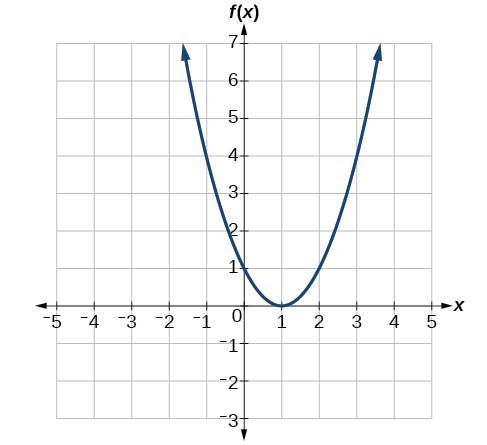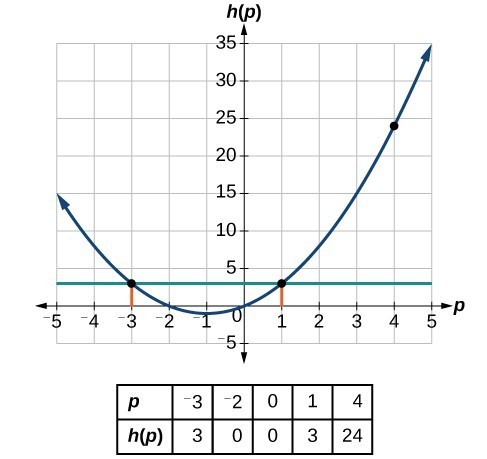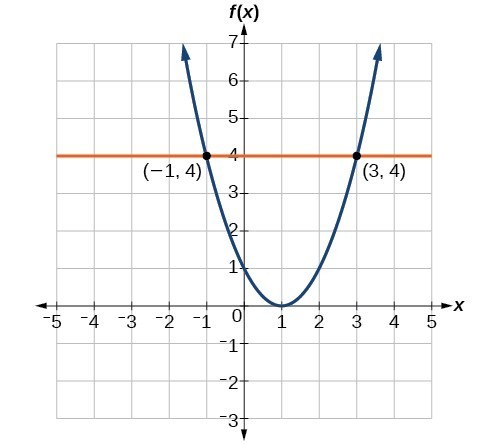Learning Outcomes
- Evaluate and solve functions in algebraic form.
- Evaluate functions given tabular or graphical data.
When we have a function in formula form, it is usually a simple matter to evaluate the function. For example, the function [latex]f\left(x\right)=5 - 3{x}^{2}[/latex] can be evaluated by squaring the input value, multiplying by 3, and then subtracting the product from 5.
How To: EVALUATE A FUNCTION Given ITS FORMula.
- Replace the input variable in the formula with the value provided.
- Calculate the result.
Example: Evaluating Functions
Given the function [latex]h\left(p\right)={p}^{2}+2p[/latex], evaluate [latex]h\left(4\right)[/latex].
Watch the video below for more examples of evaluating a function for specific values of the input.
evaluating functions
When evaluating functions, it’s handy to wrap the input variable in parentheses before making the substitution.
Ex. Given [latex]f(x)=x^2 - 8[/latex], find [latex]f(-3)[/latex]
[latex]\begin{align}f(x)&=(x)^2 - 8 \\ &= (-3)^2 - 8 \\ &= 9 - 8 \\ &= 1\end{align}[/latex]
The value of the function [latex]f(x)=x^2 - 8[/latex], at the input [latex]x=-3[/latex], is [latex]1[/latex].
Example: Evaluating Functions at Specific Values
For the function, [latex]f\left(x\right)={x}^{2}+3x - 4[/latex], evaluate each of the following.
- [latex]f\left(2\right)[/latex]
- [latex]f(a)[/latex]
- [latex]f(a+h)[/latex]
- [latex]\dfrac{f\left(a+h\right)-f\left(a\right)}{h}[/latex]
Try It
Given the function [latex]g\left(m\right)=\sqrt{m - 4}[/latex], evaluate [latex]g\left(5\right)[/latex].
We can also evaluate functions using a graphing calculator. In the previous section, recall that there was a short video showing how to evaluate a function using a TI-84 calculator.
In addition to evaluating functions for a particular input, we can also solve functions for the input that creates a particular output.
Example: Solving Functions
Given the function [latex]h\left(p\right)={p}^{2}+2p[/latex], solve for [latex]h\left(p\right)=3[/latex].
How To: Solve a Function.
- Replace the output in the formula with the value provided.
- Solve for the input variable that makes the statement true.
The next video shows another example of how to solve a function.
Try It
Given the function [latex]g\left(m\right)=\sqrt{m - 4}[/latex], solve [latex]g\left(m\right)=2[/latex].
Evaluating Functions Expressed in Formulas
Some functions are defined by mathematical rules or procedures expressed in equation form. If it is possible to express the function output with a formula involving the input quantity, then we can define a function in algebraic form. For example, the equation [latex]2n+6p=12[/latex] expresses a functional relationship between [latex]n[/latex] and [latex]p[/latex]. We can rewrite it to decide if [latex]p[/latex] is a function of [latex]n[/latex].
functions, Equations, and formulas
We’ve seen that an equation such as [latex]ax+by=c[/latex] can be written in a different form by solving the equation for one of the variables. If we solve this linear equation for y it can be written in the slope-intercept form of a line, [latex]y = mx+b[/latex].
Certain formulas can be written in function form by solving for one of the variables. For instance, can you see how to solve the formula for a rectangle having a perimeter of 21 feet, [latex]21 = 2l + 2w[/latex], for length?
How To: Given a function in equation form, write its algebraic formula.
- Solve the equation to isolate the output variable on one side of the equal sign, with the other side as an expression that involves only the input variable.
- Use all the usual algebraic methods for solving equations, such as adding or subtracting the same quantity to or from both sides, or multiplying or dividing both sides of the equation by the same quantity.
Example: Finding an Equation of a Function
Express the relationship [latex]2n+6p=12[/latex] as a function [latex]p=f\left(n\right)[/latex], if possible.
Watch this video to see another example of how to express an equation as a function.
Sometimes a relationship between variables cannot be expressed as a function. See the example below for more information.
Example: Expressing the Equation of a Circle as a Function
Does the equation [latex]{x}^{2}+{y}^{2}=1[/latex] represent a function with [latex]x[/latex] as input and [latex]y[/latex] as output? If so, express the relationship as a function [latex]y=f\left(x\right)[/latex].
Try It
If [latex]x - 8{y}^{3}=0[/latex], express [latex]y[/latex] as a function of [latex]x[/latex].
Q & A
Are there relationships expressed by an equation that do represent a function but which still cannot be represented by an algebraic formula?
Yes, this can happen. For example, given the equation [latex]x=y+{2}^{y}[/latex], if we want to express [latex]y[/latex] as a function of [latex]x[/latex], there is no simple algebraic formula involving only [latex]x[/latex] that equals [latex]y[/latex]. However, each [latex]x[/latex] does determine a unique value for [latex]y[/latex], and there are mathematical procedures by which [latex]y[/latex] can be found to any desired accuracy. In this case, we say that the equation gives an implicit (implied) rule for [latex]y[/latex] as a function of [latex]x[/latex], even though the formula cannot be written explicitly.
Evaluating a Function Given in Tabular Form
As we saw above, we can represent functions in tables. Conversely, we can use information in tables to write functions, and we can evaluate functions using the tables. For example, how well do our pets recall the fond memories we share with them? There is an urban legend that a goldfish has a memory of 3 seconds, but this is just a myth. Goldfish can remember up to 3 months, while the beta fish has a memory of up to 5 months. And while a puppy’s memory span is no longer than 30 seconds, the adult dog can remember for 5 minutes. This is meager compared to a cat, whose memory span lasts for 16 hours.
The function that relates the type of pet to the duration of its memory span is more easily visualized with the use of a table. See the table below.
| Pet | Memory span in hours |
|---|---|
| Puppy | 0.008 |
| Adult dog | 0.083 |
| Cat | 16 |
| Goldfish | 2160 |
| Beta fish | 3600 |
At times, evaluating a function in table form may be more useful than using equations. Here let us call the function [latex]P[/latex].
The domain of the function is the type of pet and the range is a real number representing the number of hours the pet’s memory span lasts. We can evaluate the function [latex]P[/latex] at the input value of “goldfish.” We would write [latex]P\left(\text{goldfish}\right)=2160[/latex]. Notice that, to evaluate the function in table form, we identify the input value and the corresponding output value from the pertinent row of the table. The tabular form for function [latex]P[/latex] seems ideally suited to this function, more so than writing it in paragraph or function form.
How To: Given a function represented by a table, identify specific output and input values.
- Find the given input in the row (or column) of input values.
- Identify the corresponding output value paired with that input value.
- Find the given output values in the row (or column) of output values, noting every time that output value appears.
- Identify the input value(s) corresponding to the given output value.
Example: Evaluating and Solving a Tabular Function
Using the table below,
- Evaluate [latex]g\left(3\right)[/latex].
- Solve [latex]g\left(n\right)=6[/latex].
| [latex]n[/latex] | 1 | 2 | 3 | 4 | 5 |
| [latex]g(n)[/latex] | 8 | 6 | 7 | 6 | 8 |
Try It
Using the table from the previous example, evaluate [latex]g\left(1\right)[/latex] .
Finding Function Values from a Graph
ordered pairs of inputs and outputs
We can view a function as a set of inputs and their corresponding outputs. That is, we can see a function as a set of ordered pairs, [latex]\left(x, y \right).[/latex]
Remember that, in function notation, [latex]y = f(x)[/latex], so the ordered pairs containing inputs and outputs can be written in the form of (input, output) or [latex]\left(x, f(x)\right)[/latex].
Evaluating a function using a graph also requires finding the corresponding output value for a given input value, only in this case, we find the output value by looking at the graph. Solving a function equation using a graph requires finding all instances of the given output value on the graph and observing the corresponding input value(s).
Example: Reading Function Values from a Graph
Given the graph below,
- Evaluate [latex]f\left(2\right)[/latex].
- Solve [latex]f\left(x\right)=4[/latex].

Try It
Using the graph, solve [latex]f\left(x\right)=1[/latex].

Try It
You can use an online graphing calculator to graph functions, find function values, and evaluate functions. Watch this short tutorial to learn how to within Desmos. Other online graphing tools will be slightly different.
Now try the following with an online graphing calculator:
- Graph the function [latex]f(x) = -\frac{1}{2}x^2+x+4[/latex] using function notation.
- Evaluate the function at [latex]x=1[/latex]
- Make a table of values that references the function. Include at least the interval [latex][-5,5][/latex] for [latex]x[/latex]-values.
- Solve the function for [latex]f(0)[/latex]
Here is a video showing how to create a table using a TI-84+ graphing calculator.
Candela Citations
- Revision and Adaptation. Provided by: Lumen Learning. License: CC BY: Attribution
- Question ID 111699. Provided by: Lumen Learning. License: CC BY: Attribution. License Terms: IMathAS Community License CC-BY + GPL
- College Algebra. Authored by: Abramson, Jay et al.. Provided by: OpenStax. Located at: http://cnx.org/contents/9b08c294-057f-4201-9f48-5d6ad992740d@5.2. License: CC BY: Attribution. License Terms: Download for free at http://cnx.org/contents/9b08c294-057f-4201-9f48-5d6ad992740d@5.2
- Question ID 1647. Authored by: WebWork-Rochester, mb Lippman,David, mb Sousa,James. License: CC BY: Attribution. License Terms: IMathAS Community License CC-BY + GPL
- Question ID 97486. Authored by: Carmichael,Patrick. License: CC BY: Attribution. License Terms: IMathAS Community License CC-BY + GPL
- Question ID 15766, 2886. Authored by: Lippman,David. License: CC BY: Attribution. License Terms: IMathAS Community License CC-BY + GPL
- Question ID 3751. Authored by: Lippman, David. License: CC BY: Attribution. License Terms: IMathAS Community License CC-BY + GPL
- Question ID 2471. Authored by: Greg Langkamp. License: CC BY: Attribution. License Terms: IMathAS Community License CC-BY + GPL
- Learn Desmos: Functions. Located at: https://youtu.be/jACDzJ-rmsM. License: All Rights Reserved. License Terms: Standard YouTube License

